Keeping a mango tree small makes a lot of sense. First, we’ll cover the reasons for maintaining small mango trees, then we’ll see how to keep a mango tree small through pruning.
Have you ever seen a mango like this?
Giant mango trees are very common in tropical climates. If left to themselves, mangoes reach for the heavens sky, towering above buildings and people and bombing the ground with fruit that explode on impact.
Some time ago I wrote about picking mangoes in South Florida. My father-in-law has to harvest mangoes with a long pole as someone else attempts to catch them.
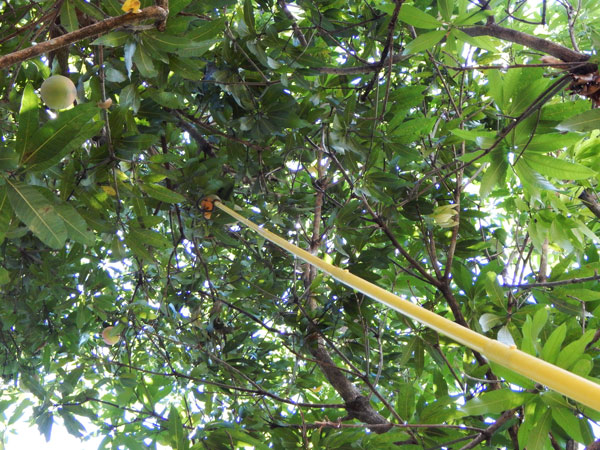
The trees are beautiful and provide a lot of shade, but a lot of mangoes go to waste.
You don’t have to let your mangoes grow to look like this:
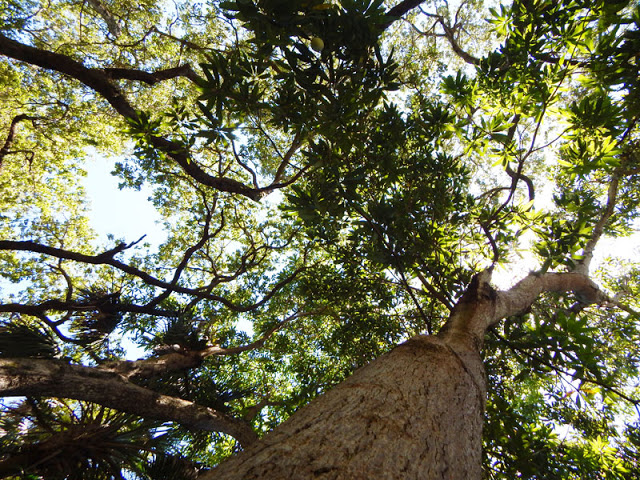
Instead, you can keep mango trees small with judicious pruning, even maintaining them at a size that would work in a tiny backyard.
Keeping Mango Trees Small
In this video from Ghana, you’ll see the difference between huge mango trees grown traditionally and trees that are pruned to remain small and manageable:
Here’s one of the farmers in his traditional mango orchard:
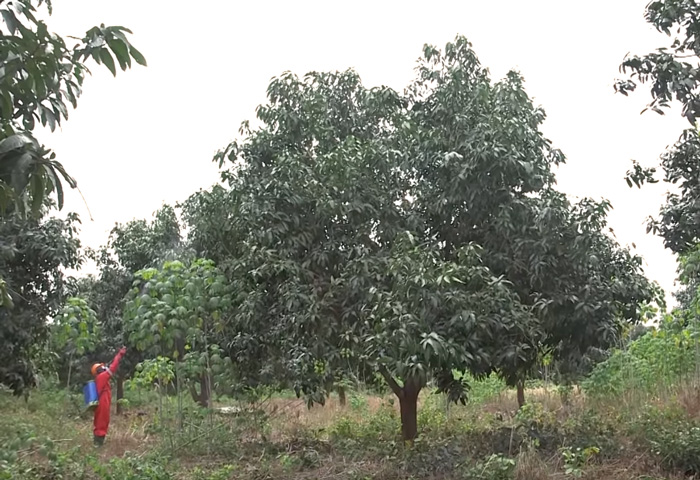
And here is a tree pruned for easy access:
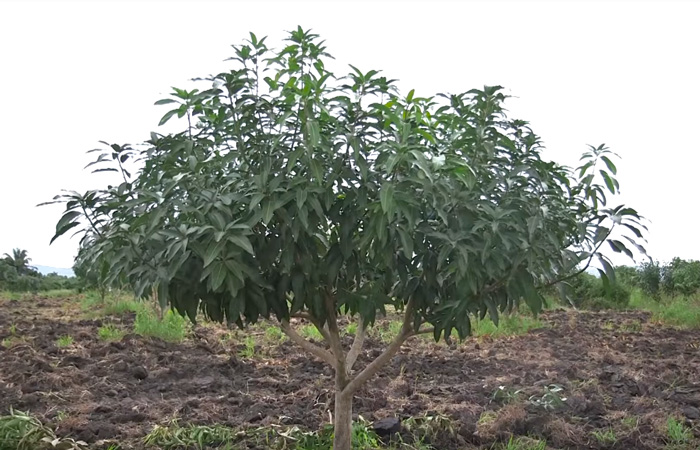
Which tree would fit better in your backyard?
As shared in the video, the benefits of small mango trees are many.
Disease Control
An open canopy is less likely to get fungal diseases. Air and light penetrate the interior. Smaller trees also allow for better application of fungicides, if needed.
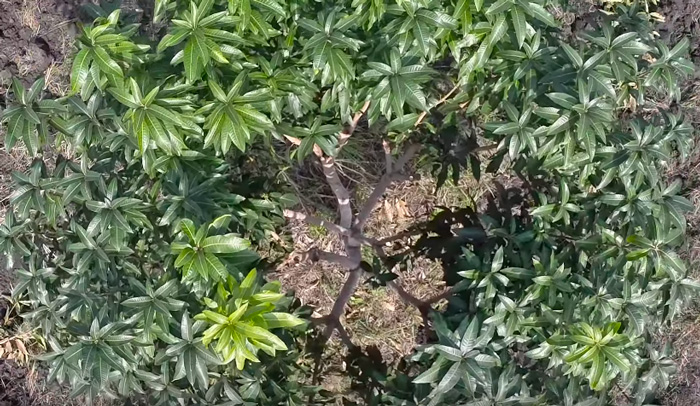
I had to spray a huge grapefruit tree with neem a couple of weeks ago and I wasted a lot of spray trying to hit the top. The breeze carries away the mist, plus you have little control when you’re shooting that high into the air.
Flower Production
Much of the energy of a properly pruned mango tree goes into fruit, with flower heads maturing at the same time.
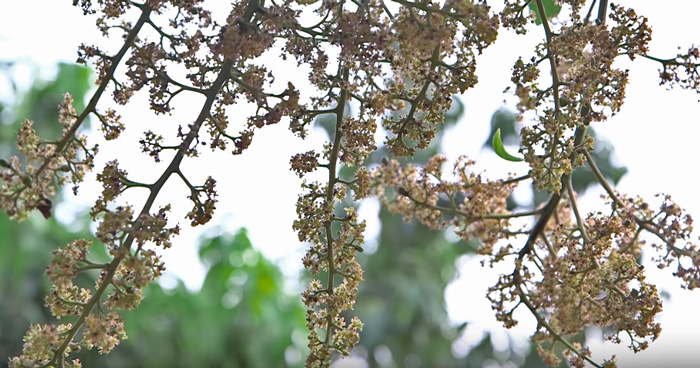
This is easier for farmers heading to market, as the fruit can be harvested in a reasonable season.
For backyard gardeners it isn’t as important; however, it is a good thing to get your trees working to make blooms, not branches and leaves.
Profitability
If you keep a mango tree small, you can increase the size of the fruits by thinning as needed and getting much better light into the tree, as well as being able to care for it much better.
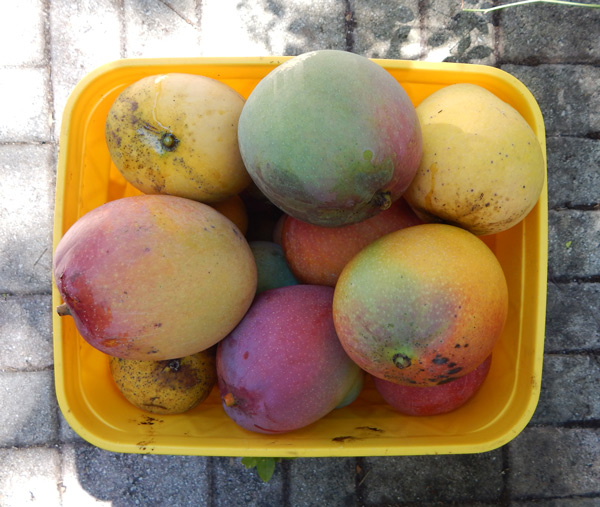
You can also fit more trees trees into the same space. Check out this graphic from the video:
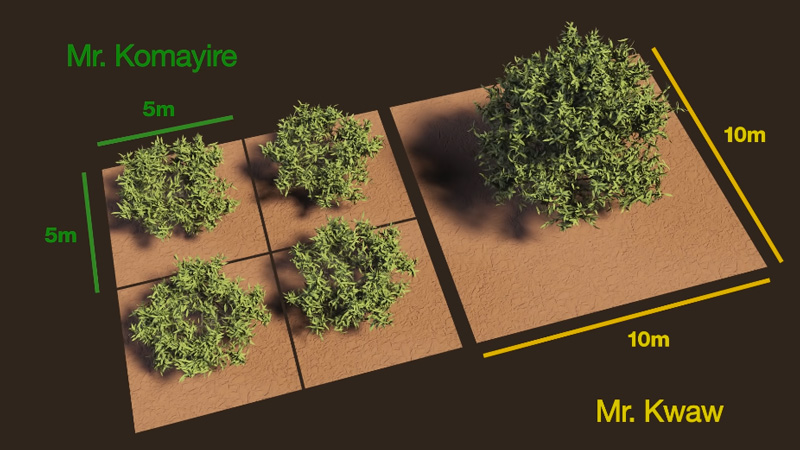
On the left are four mango trees kept small through pruning. Though the large tree on the right may produce twice the fruit as one of those small trees, when you have four small trees, the yield is twice as high for the space used than a single large tree.
In a backyard, you could have four varieties of mango growing instead of just one.
According to research, small trees will also yield higher over time and stay productive for more decades than giant, unpruned trees.
Easier Harvest
It goes without saying that it’s much easier to pick fruit you can reach, rather than climbing up into a tree or picking with a pole like my father-in-law has to do:
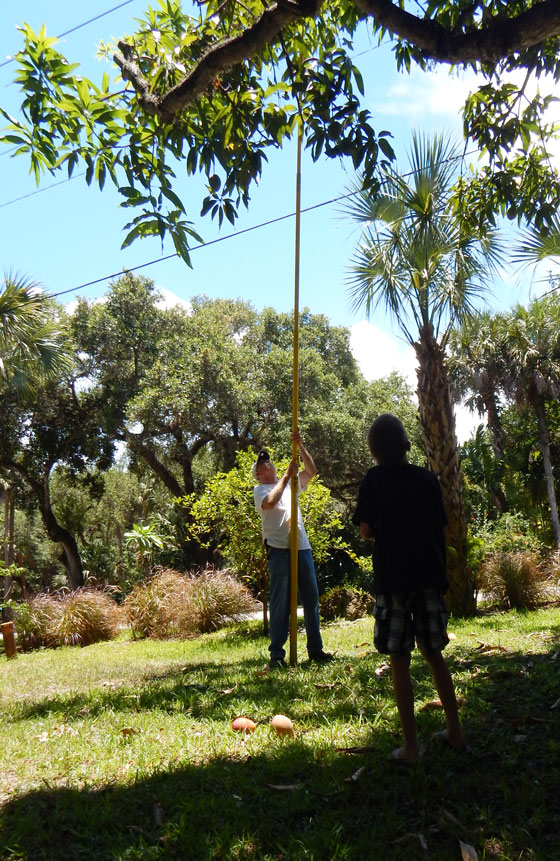
It’s not his fault he ended up with gigantic mango trees. They were already large when he moved into the house. However, if you have the chance to start from scratch, why not keep your trees small so you can pick them without the rick of getting bonked on the head or going out on a limb?
Higher Quality Fruit
If you have hand-picked fruit without fungal or bacterial blemishes, you can sell them for higher prices. Small mango trees that are well-pruned will give you more high-quality mangoes than giant trees that are dark inside. They produce a range of sizes and a lot more spotted fruit, never mind the fact that fruit that fall from high above get bruised and damaged.
How to Keep Mango Trees Small
With fruit trees, remember – YOU are in charge! You don’t have to have a 60-foot tree in your yard, and you probably don’t WANT a 60-foot tree in your yard.
From the same makers of the film on small mango trees comes a second excellent video showing just how they keep mango trees under control, year after year:
I have a Julie mango tree on my new property that needs the restorative treatment, as it’s now too tall to be managed well.
With the new mangoes I’ll be planting next month, we’ll stay on top of pruning right from the beginning.
If you think you don’t have room for a mango tree in your yard, think again. You can keep them at 8′ or less in height, without buying a “dwarf” variety. Stay on top of pruning and you’ll be able to grow more fruit and more varieties than you ever thought possible.

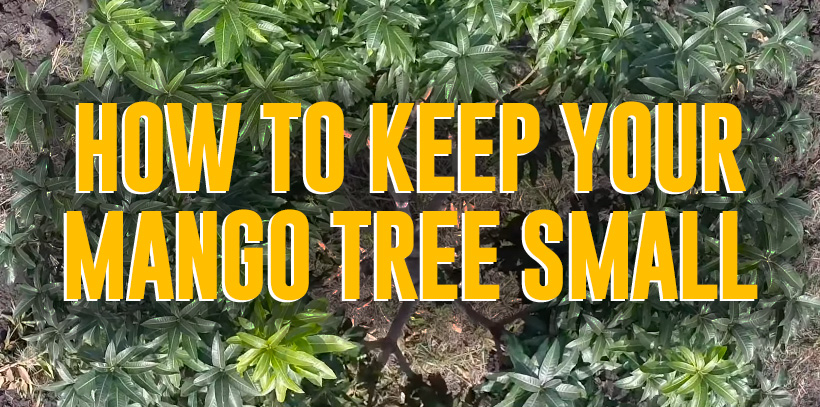
34 comments
I’d love to see how you’ll go about reducing the canopy of that large Julie. I have a monster in my backyard which could stand to lose about 30 feet of height.
I’ll make sure I film a video when I prune it back. Sometimes it makes sense to just cut the whole tree down to a few feet and let it start over.
Thumbs up on sharing these videos. We have started a mango from seed and I was very concerned about growing the tree due to space. Now I feel better.
Fear not! Just prune. Glad to hear it.
I saw the picture of a breadfruit tree in the center of a lady’s yard. She has it pruned to a size where she can stand on the ground and pick her breadfruits with her hands. I was amazed. Grenada grows lots of breadfruit trees. They are all tall and big. No one seems to think or know that trees can be prune to a small size yet produce fruits. The African farmers are great at keeping their fruit trees pruned. I have look at a few of their videos. I keep my paw paw(papaya) trees pruned so they do not get very tall.
That is really cool – I would love to see a picture of that tree. It makes sense. Breadfruit gets way too big if unpruned.
Those videos were really interesting! I live in a Mediterranean climate though so I don’t have mangoes. I assume these ideas can be applied to stonefruit like cherries, peaches, apricots, and citrus? Most of our trees aren’t baby ones but maybe they can still be trained somewhat.
Yes, they can definitely be kept small – it’s not very different!
When you posted this, I watched the videos, then took a picture of my out of control six year old mango tree I planted from seed. I’m going to prune it as soon as I harvest all the mangos. The pruning information in the videos is exactly what I was needing, and it’s not too late! Thanks!
Wonderful, Sheri! I found it quite good – had to share.
Send before and after pics when you prune and I’ll post ’em.
[…] what everyone else is growing. I’m going to plant dozens of seedling mangoes in my yard, keep them small, then see what […]
well…where’s the way or the lesson on how to keep mango tree small..! what i’m looking for, is your teaching factor on how to control mangoes to grow big. !
well…where is your lesson or teaching procedure on how to keep mango tree small.?
Watch the videos.
Hi! I know this article is from last year, but perhaps someone will answer me this year. I keep reading that Valencia Pride mango trees cannot be kept small as I have learned from your site. Is that true? Is it depending on the type of mango? Or can this information be applied across all mangos. I have a small yard and recently purchased a Valencia Pride not knowing it is going to be a larger mango tree than others. She is still in the pot, but I would like to keep her. Thank you for any information.
You can keep her small.
im growing a mango dwarf tree in my balcony
I’m growing a mango tree from a seed, I’m curious as to how tall it’ll grow inside. I live in Chicago, IL where the winter’s are brutal and cold. I have my plant in a south window and it’s growing pretty fast. I had started one previously but due to me not watching it as I should have, spider mites invaded it and even after clearing them away it died. I have a new one that I also started from a mango seed and it’s about a foot tall already. This one though, I’m keeping a close eye on. I’ll keep you updated with its progress. And by the way, I also have four lemon trees that I keep a close eye on. Any advice would be helpful. Thomas Mckee
We live in a tropical climate. We had a huge mango tree (over 40’ tall) that was planted 20 feet from our apartment building many years ago. It was heavily pruned last year. The pruning company removed many huge branches and opened up the interior. They also removed 10-15’ from the crown. It has responded with amazing new growth. Now we are worried this might make the roots more invasive. We don’t want to lose our tree. What do you think?
Heavily pruning a tree will not make roots more invasive. Typically trees have almost as much mass in the ground as in the air. Any concerns on invasive roots were going to happen anyway. Mangos are not known to be particularly disrupting with their roots. I have planted more than 20 trees near my last 3 houses and have had no issues or lifting of any concrete. This spans 30 years of observation.
Right – the tree should instead drop some roots in response to losing canopy.
Would you be interested in writing a post on your mango growing, Jerry? I would love to share it.
This video is spot on. I planted a 7 gallon mango tree 14 months ago. It’s trunk was about the width of a pencil and it was about 2 1/2 feet tall. Fast forward 14 months and the tree is well over 8 feet tall and 10 feet across with the trunk diameter over 5 inches. They grow extremely fast in South Florida.
I have two huge mango trees in my farm house, one of them is almost 120 years old that definitely requires pruning the other one is maximum 5-6 years old but it doesn’t bear much fruits, I will prune it this time after harvest thanks for the videos
You are welcome. I cut back a ten-year-old tree and it did very well. I took 1/3 off the top.
Why would you grow a mango tree from seed ( or any other fruit tree) ? It will take years for it to have fruit, and its nasty. Why not purchase a grafted tree ? easier and you can be eating fruit in a short time.
Unfortunately, your view is all too common. First of all, not all fruit trees take a long time to produce. Secondly, where do you get the idea the fruit will be nasty? That’s ridiculous. Yes, it won’t be the same commercial variety you see in the store, but all the seedling trees I have tasted fruit from have been just fine. If you want the same thing everyone else has, go for grafted. It has its benefits. But those of us who love experimenting and creating new varieties grow trees from seed.
We live in Qld Australia which I think will have a similar climate to yours, and we have been pruning our mango tree since it has been in the ground. We are getting some amazing and very tasty fruit from it now for 2 years but are worried about the root system doing damage to a building and the septic system. If we keep pruning it, will this also stop the roots from spreading?
Hi Freda – thanks for writing. From what I have read, pruning does reduce root growth. If you are really concerned, you can also dig a trench a foot or more deep between the tree and where buildings/septic is located, stopping the roots from reaching that area. Some people bury a boundary material, too. Generally, though, hedge-sized plants are often just fine – I don’t worry about them making much trouble. A full-size mango is a monster, but a little one shouldn’t be much trouble as it doesn’t have the canopy to support a large and invasive root system.
how long does it take to grow a small mango tree and how long does it take to get the first harvest?
Hello, growing a mango tree is new to me. My son bought me a 6 foot tall mango, nursery said it is 5 years old, it has no branches, it is a Glenn dwarf mango, we have replanted into a larger container. It will have to be brought inside during winter. Not really sure what I need to do with it or where to cut to start it branching. Help? Thanks!
email me a picture if you can – with someone standing beside it for scale. david@floridafoodforests.com
I have a mango I grew from seed about 4 months ago growing right next to the wall. I only have these planting spaces next to the wall with rest of the ground paved. I’m wondering if I should uproot it and grow in a pot to prevent it from breaking the fence. Would pruning keep it small enough to keep if growing next to the fence without damaging the fence or would it be better off uprooted and planting in a pot?
They are quite vigorous – it’s definitely a risk to a fence.
Comments are closed.